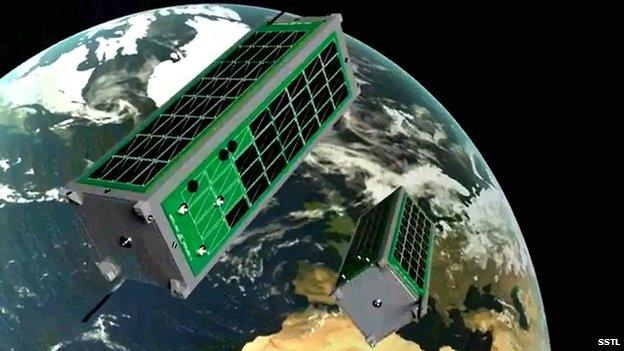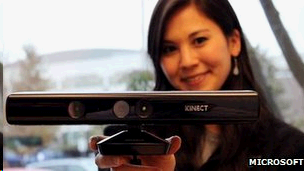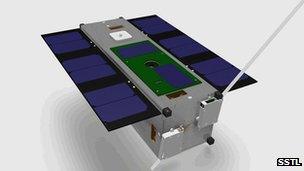Thinking outside the box in space
- Published
- comments

The Strand-2 mission would comprise two nano-sats, each some 30cm in length
The latest consumer electronics device seems to hold its novelty these days for about as long as a gnat can concentrate. No sooner have you opened the packaging than you're already yearning for the upgrade. It's a fast paced world, and one of the few examples where "better" seems to cost less as time progresses.
No wonder other industries are trying to capture the same magic, and the space sector is no exception.
The British satellite manufacturer SSTL has had a good deal of success down the years by incorporating components into its spacecraft that would ordinarily be used in laptops. "Off the shelf" has lowered the price of the Guildford company's products, and it's constantly on the look-out for that next clever cross-over.
So, enter Microsoft's XBox Kinect. For those who don't play video games at home and need a little education (that's me!), this is a motion sensor system that allows you to interact with the Xbox 360 console without the need to touch any sort of hand controller.
Just sway one way, and the infrared scanner in the Kinect will sense your movement and tilt your surfboard to the left; jump, and Kinect will lift your on-screen avatar into the air.
It's a smart piece of kit that became one of the fastest selling consumer electronics devices of all time when it was released in 2010.
So, what could you do with it in space? Well, the engineers at SSTL, external and the University of Surrey, external think the technology in Kinect could form the basis of a novel in-orbit proximity sensor and docking system. And they plan to try it out.
Come together
The Surrey team has a cubesat programme called Strand (Surrey Training, Research and Nanosatellite Demonstrator, external).
You may have heard of this already. The first Strand cubesat currently in development will incorporate a Google Nexus One Android phone. It should launch later this year.
The satellite-borne phone will map the Earth with its 5 megapixel camera and conduct a number of scientific and engineering experiments, the most significant of which will be to hand total control of the spacecraft over to the Nexus. That's never been done before.

The Kinect has been a huge success since its launch in late 2010
The Strand-2 project which has just been initiated will see two cubesats launched together on the same rocket.
Once in orbit, these little satellites will separate for a short period to conduct systems checks. Then, when the engineers are ready, the cubesats will be commanded to use their on-board Kinect technology to find each other and dock together.
The Surrey researchers have been developing a simple magnetic docking system that works like a cup and cone. The pair will join, separate, join, separate, and so on.
Shaun Kenyon from SSTL told me: "Kinect uses an infrared laser to pepper its surroundings, building up a 3D model of the space immediately in front of it. A webcam on the box also overlays a picture on to the distance information provided by the laser.
"There are quite a lot of YouTube videos out there of people using the Kinects in different applications rather than just playing computer games with them.
"We saw one really cool idea where someone had taken the electronics from the Kinect and put it on a hobby quadrotar, external.
"This unit was completely autonomous and it could fly around a room. Because it had the Kinect, it was building up a 3D model of its surroundings as it was flying. So, we thought why not use this technology in space as part of a docking system."
Low-cost space
Where can you go with this? The Strand team sees it as perhaps the start of intelligent "space building blocks" that could be stacked together and reconfigured to build larger modular spacecraft.
We may not be about to see space stations being built this way anytime soon, but one can very easily envisage "snap-on" auxiliary satellites that provide backup power, propulsion or even additional on-board computing to another spacecraft.

Strand-1 is likely to launch at the end of the year
Space junk is a big topic for discussion currently, also. So, maybe you could snap on devices to help bring redundant satellites out of the sky faster than would otherwise be the case.
Meanwhile, watch out for Strand-1. One of its experiments is called "Scream in Space" and was suggested by Cambridge University students.
This will see the Nexus phone play videos of people screaming to test the famous Alien movie poster statement: "In space, no-one can hear you scream", external.
In a vacuum, this is certainly true… but probably only up to a point. It's quite likely the phone's microphone will sense a scream emitted from its speakers if only because they're connected to each other on the same candy bar structure.
"This is all about finding out whether these newer electronics are suitable for use in space. The way we'll know is if we fly them," says Kenyon.
"They may not perform well. There are radiation issues, and there are temperature issues to contend with.
"There are also power constraints: when your mobile phone runs out of juice, it's easy enough to re-charge it; but in space you're dependent on the solar panels and you cannot be constantly re-charging. The power has to be managed. But that said, the electronics found in consumer devices are incredibly powerful and very, very cheap. If we can show these new chips are useful in space, that's very good for our future technology development."